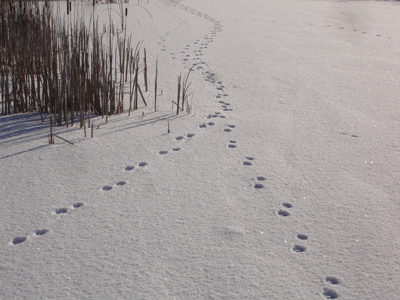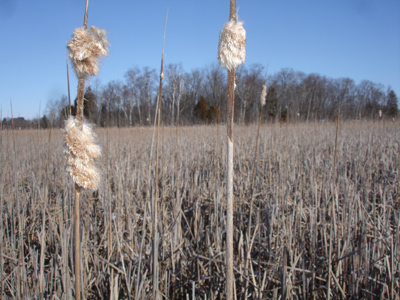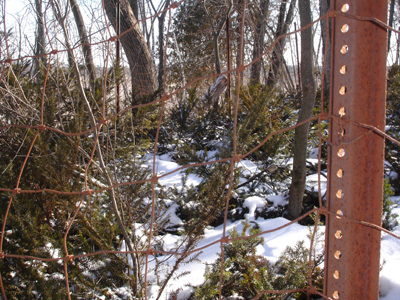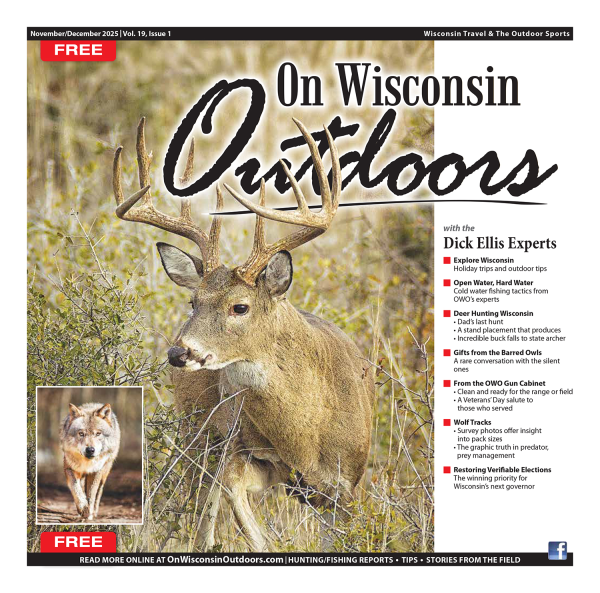FENCEROWS...Snowshoe Secrets of Mud Lake
By John Luthens
Mud Lake doesn’t sound like much when you look at it strictly on a first name basis. Even reading its statistics doesn’t invoke much more than a yawn: 165 acres with a maximum depth of around four feet. In the winter the dissolved oxygen content falls so low that the only fish to survive are mud minnows that bury deep in the muck bottom.
The lake is only a half-hour north of Milwaukee and sits in the heart of Ozaukee County, with rural lands scattering into urban sprawl in all directions. It isn’t exactly set in a pristine wilderness-but it does make up a part of the southern boundary of the Cedarburg Bog State Natural Area, which covers 2200 acres of undisturbed wetland bog. So it has that going for it.
It’s true that duck hunters set up blinds in the vast mazes of cattails and willow patches that bend across the lake, and hearty deer hunters venture into the thick winterberry brush tangles of the shoreline. And there are several upland islands in the back corner of the lake, with cedar trees and hardwoods rising invitingly above.
But in the winter, snow blows vacant over the far reaches, cattails and marsh grass bend in the cold wind, and there just doesn’t seem to be any point in bothering with Mud Lake at all. In other words, not too many people get back there.
However, every wild place harbors secrets. You never know what you will find if you don’t judge a book by its cover. Mud Lake is the perfect place for a late-winter snowshoeing expedition.
It wasn’t that I needed the snowshoes for the deep snow. It’s just that I have them and I needed to justify the cost of what I paid for them. Besides, if you hit a muskrat runway on one of the side channels of the lake, hopefully the webbing disperses the weight and you can feel the ice give beneath your feet before it becomes too late. Sometimes it doesn’t work out that way. I packed along dry socks just in case.
I followed a coyote track onto the lake. Two of them had come through sometime in the early morning hours, and a light dusting of snow told the tale of their travels. They went across at an easy trot, judging by the evenly spaced prints upon the frozen surface of Mud Lake.

Coyote tracks winding across Mud Lake.
I could even picture the relative length of their legs. One of the two tracks was spaced a little wider than the other. They wound through icy openings in the cattails and stopped to dig in likely clusters of marsh grass, though I found no sign of a kill. The coyotes were intent on heading deeper into the bog, and our paths diverged when I struck out across the open lake for one of the upland islands.
There are three islands in the back stretches of the lake. The first one is smaller and rises on private land. It is a near replica of its bigger sister further to the north that falls within DNR boundaries, the only difference being that the smaller of the two is totally surrounded by open water, while the border of the bigger one is tightly packed in waist high cattails and sedge grass and takes a little deer-path navigating to reach.

Cattail view of a Mud Lake island.
A third island is even more tightly packed in brush and marsh. This island is connected via a boardwalk to the University of Wisconsin-Milwaukee Field Station that adjoins the Cedarburg Bog. I had contacted field station director Dr. James Reinartz to let him know I would be poking around the islands, as I didn’t want to disrupt any ongoing research projects.
Dr. Reinartz gave his permission, and told me there was plenty of good ice left on the lake, but warned that the upwelling from springs made the island approaches a bit suspect, especially in the cattails. He also told me to be careful of poison sumac, which is prevalent in the bog and extremely hard to identify in winter. The resin from the bark of poison sumac raises an itchy rash that makes poison ivy seem a walk in the park. Needless to say, I’ve never picked through brush more carefully.
Reinartz has researched the Bog area for over 30 years and stressed the uniqueness of the place. “If you wanted to put your thumb on a map of southeastern Wisconsin, and find the area with the highest density of plant communities, the Cedarburg Bog area would be it.” Reinartz said.
Research conducted at the Field Station ranges from bird studies, white-tailed deer densities and the effects of over-browsing on plant species, to habitat studies of a rare species of dragon fly. Several bird species and plants in the Bog are at there southern-most range, due to the vastness of the wetlands and the relative closeness to the cooling effects of Lake Michigan.
I made my way toward the state-owned island slopes, ringed with cedar shadows on the lowest reaches, and sloping steeply upward into birch, maple and basswood hardwoods. I picked my way through deer runways in the cattails, with the ice feeling softer at every step. I came to some dead ends where the marsh was simply to thick to get through on snowshoes and back-tracked to try again.
I got lucky and gained the slopes without wet feet, climbing upward into the recesses of the island. In the tangles were two fenced in areas the size of a modest backyard, with spreading braches of tangled evergreens blanketing the insides-a veritable deer smorgasbord of Canada yew.

Fenced tangles of Canada yew.
The Canada yew, also known as ground hemlock, is a bushy tree that spreads its branches close to the ground. When it is allowed to grow unchecked, it resembles a miniature Christmas tree farm gone wild. There was thick green running rampant in the enclosures, and not a bit of it outside the fence boundaries.
It is a food that white-tailed deer prize above any other that they find in the wild. It doesn’t fair well in the face of over-browsing, and the species of tree has been nearly extirpated from most of Wisconsin because of it. Apparently it is prized by other island-roaming mammals also. As the moose population grew on Isle Royale, Michigan, the Canada yew on the island was virtually wiped out.
Field Station research supplements local DNR data, and researchers work to maintain the fences on the state land as well as the UWM property. According to Dr. Reinartz, fencing off areas of the Canada yew is the only way to study its growth rate in a controlled environment, versus unchecked areas where deer naturally browse.
“I think some of those fences have stood since the 1970’s,” Dr. Reinartz said. “And it’s interesting to note that the privately owned island, which doesn’t have any fences, was covered in Canada yew when I first started researching here. As the deer herd grew progressively bigger, the yew started disappearing. Now you don’t find a trace of it on that island.”
I took some pictures, climbing over the islands and seeing what there was to see in the remote stretches of Mud Lake. Rare Canada yew, deer sign, rabbit sign-I found a wasp nest hung high in the branches and outlined sharply against the light clouds that rode a blue February sky. I followed trails and simply spent a morning doing nothing more than poking around.
When I followed my snowshoe tracks back across the lake, they had already begun to melt around the edge, slowly seeping back into Mud Lake. Spring wouldn’t be far behind, and unless I built a raft out of the tamarack trees that sprout high on the edges of the Cedarburg Bog, another winter might have to pass until I got back to the secret islands again.







